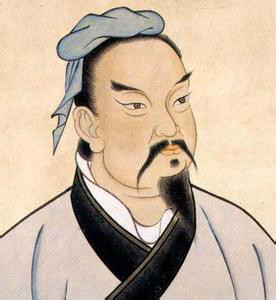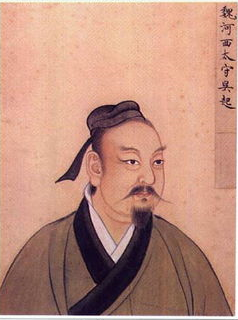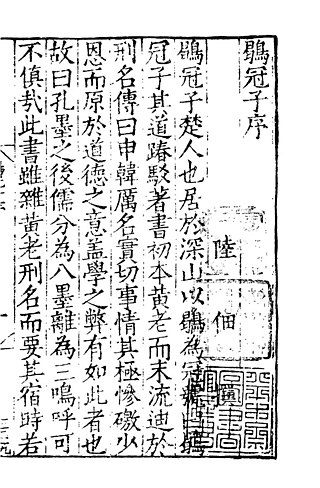The Chinese classics or canonical texts are the works of Chinese literature authored prior to the establishment of the imperial Qin dynasty in 221 BC. Prominent examples include the Four Books and Five Classics in the Neo-Confucian tradition, themselves an abridgment of the Thirteen Classics. The Chinese classics used a form of written Chinese consciously imitated by later authors, now known as Classical Chinese. A common Chinese word for "classic" literally means 'warp thread', in reference to the techniques by which works of this period were bound into volumes.

The Qin dynasty was the first dynasty of Imperial China. It is named for its progenitor state of Qin, which was a fief of the confederal Zhou dynasty that had endured for over five centuries. Beginning in 230 BC, the Qin under King Ying Zheng engaged in a series of wars conquering each of the rival states that had previously pledged fealty to the Zhou. This culminated in 221 BC with the successful unification of China under Qin, which then assumed an imperial prerogative—with Ying Zheng declaring himself to be Qin Shi Huang, the first emperor of China. This state of affairs lasted until 206 BC, when the dynasty collapsed in the years following Qin Shi Huang's death.

Sun Tzu was a Chinese military general, strategist, philosopher, and writer who lived during the Eastern Zhou period. Sun Tzu is traditionally credited as the author of The Art of War, an influential work of military strategy that has affected both Western and East Asian philosophy and military thought. Sun Tzu is revered in Chinese and East Asian culture as a legendary historical and military figure. His birth name was Sun Wu and he was known outside of his family by his courtesy name Changqing. The name Sun Tzu—by which he is more popularly known—is an honorific which means "Master Sun".

The Warring States period in Chinese history comprises the final centuries of the Zhou dynasty, which were characterized by warfare, bureaucratic and military reform, and political consolidation. It followed the Spring and Autumn period and concluded with the wars of conquest that saw the state of Qin annex each of the other contender states by 221 BC and found the Qin dynasty, the first imperial dynastic state in East Asian history.

Fajia, or the School of fa, often translated as Legalism, is a school of mainly Warring States period classical Chinese philosophy. Often interpreted in the West along realist lines, its members works contributed variously to the formation of the bureaucratic Chinese empire, and early elements of Daoism. The later Han takes Guan Zhong, associated with the Guanzi, as forefather of the Fajia. Its more Legalistic figures include ministers Li Kui and Shang Yang, and more Daoistic figures Shen Buhai and philosopher Shen Dao, with the late Han Feizi drawing on both. Later centuries took Xun Kuang as a teacher of Han Fei and Li Si. Succeeding emperors and reformers often followed the templates set by Han Fei, Shen Buhai and Shang Yang, but the Qin to Tang were more characterized by their traditions.

Han was an ancient Chinese state during the Warring States period of ancient China. Scholars frequently render the name as Hann to clearly distinguish it from China's later Han dynasty.

Zhao was one of the seven major states during the Warring States period of ancient China. It emerged from the tripartite division of Jin, along with Han and Wei, in the 5th century BC. Zhao gained considerable strength from the military reforms initiated during the reign of King Wuling, but suffered a crushing defeat at the hands of Qin at the Battle of Changping. Its territory included areas in the modern provinces of Inner Mongolia, Hebei, Shanxi and Shaanxi. It bordered the states of Qin, Wei, and Yan, as well as various nomadic peoples including the Hu and Xiongnu. Its capital was Handan, in modern Hebei province.
Duke Xiao of Qin, personal name Ying Quliang, was the ruler of the Qin state from 361 to 338 BC. Duke Xiao is best known for employing the Legalist statesman Shang Yang from the Wey state and authorizing him to conduct a series of ground breaking political, military and economic reforms in Qin. Although the reforms were controversial and drew violent opposition from many Qin politicians, Duke Xiao supported Shang Yang fully and the reforms did help to transform Qin into a dominant superpower among the Seven Warring States.
For most of its history, China was organized into various dynastic states under the rule of hereditary monarchs. Beginning with the establishment of dynastic rule by Yu the Great c. 2070 BC, and ending with the abdication of the Xuantong Emperor in AD 1912, Chinese historiography came to organize itself around the succession of monarchical dynasties. Besides those established by the dominant Han ethnic group or its spiritual Huaxia predecessors, dynasties throughout Chinese history were also founded by non-Han peoples.
In Chinese philology, the Ancient Script Classics refer to some versions of the Five Classics discovered during the Han dynasty, written in a script that predated the one in use during the Han dynasty, and produced before the burning of the books. The term became used in contrast with "Current Script Classics" (今文經), which indicated a group of texts written in the orthography currently in use during the Han dynasty.
The Seven Military Classics were seven important military texts of ancient China, which also included Sun-tzu's The Art of War. The texts were canonized under this name during the 11th century AD, and from the time of the Song dynasty, were included in most military leishu. For imperial officers, either some or all of the works were required reading to merit promotion, like the requirement for all bureaucrats to learn and know the work of Confucius. The Art of War was translated into Tangut with commentary.

The Wuzi is a classic Chinese work on military strategy attributed to Wu Qi. It is considered one of China's Seven Military Classics.

The Six Secret Teachings, is a treatise on civil and military strategy traditionally attributed to Lü Shang, a top general of King Wen of Zhou, founder of the Zhou dynasty, at around the eleventh century BC. Modern historians nominally date its final composition to the Warring States period, but some scholars believe that it preserves at least vestiges of ancient Qi political and military thought. Because it is written from the perspective of a statesman attempting to overthrow the ruling Shang dynasty, it is the only one of the Seven Military Classics explicitly written from a revolutionary perspective.
The Methods of the Sima is a text discussing laws, regulations, government policies, military organization, military administration, discipline, basic values, tactics, and strategy. It is considered to be one of the Seven Military Classics of ancient China. It was developed in the state of Qi during the 4th century BC, in the mid-Warring States period.

Questions and Replies between Emperor Taizong of Tang and Li Weigong is a fictional dialogue between Emperor Taizong of the Tang dynasty and Li Jing, a prominent Tang general. It discusses matters of military strategy, and is considered to be one of the Seven Military Classics of China.

The Three Strategies of Huang Shigong is a treatise on military strategy that was historically associated with the Taoist hermit Huang Shigong and Han dynasty general Zhang Liang. Huang Shigong gave this treatise to Zhang Liang, that allowed Zhang to transform into an adept statesman and powerful war theorist. The treatise's literal name is "the Three Strategies of the Duke of Yellow Rock", based on the traditional account of the book's transmission to Zhang. Modern scholars note the similarity between its philosophy and the philosophy of Huang-Lao Daoism. It is one of China's Seven Military Classics.
The Shizi is an eclectic Chinese classic written by Shi Jiao 尸佼, and the earliest text from Chinese philosophical school of Zajia, which combined ideas from the Hundred Schools of Thought, including Confucianism, Daoism, Mohism, and Legalism. The Shizi text was written c. 330 BCE in twenty sections, and was well known from the Han dynasty until the Song dynasty (960–1279) when all copies were lost.
The following outline is provided as an overview of and topical guide to ancient China:

The Heguanzi is a circa 3rd century BCE syncretic collection of writings from the Chinese Hundred Schools of Thought, particularly the schools of Huang-Lao, Daoism, Legalism, and the Military. The 111 CE Book of Han history is the earliest extant source to mention the Heguanzi, yet the next reliable sources referring to it date from the early 6th century. In 805, the influential Tang dynasty writer Liu Zongyuan found a copy of the Heguanzi and disparaged it as a post-Han apocryphal forgery. His opinion was widely accepted by scholars for the next twelve centuries, during which the text was seldom read and infrequently mentioned. Then, in 1973, Chinese archeologists unearthed the 2nd-century BCE Han dynasty Mawangdui Silk Texts, including the previously unknown Huang-Lao Silk Manuscripts, which have many passages similar and identical with the Heguanzi, leading to renewed studies into its textual history and philosophical significance.











